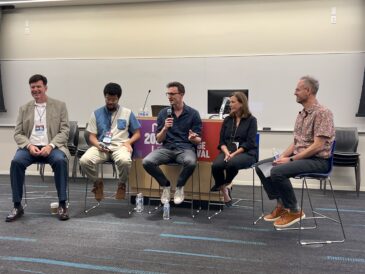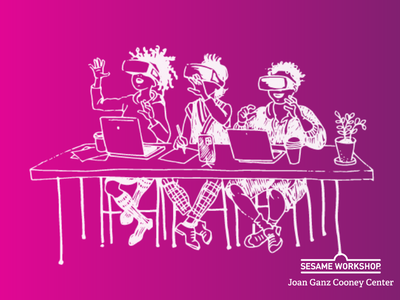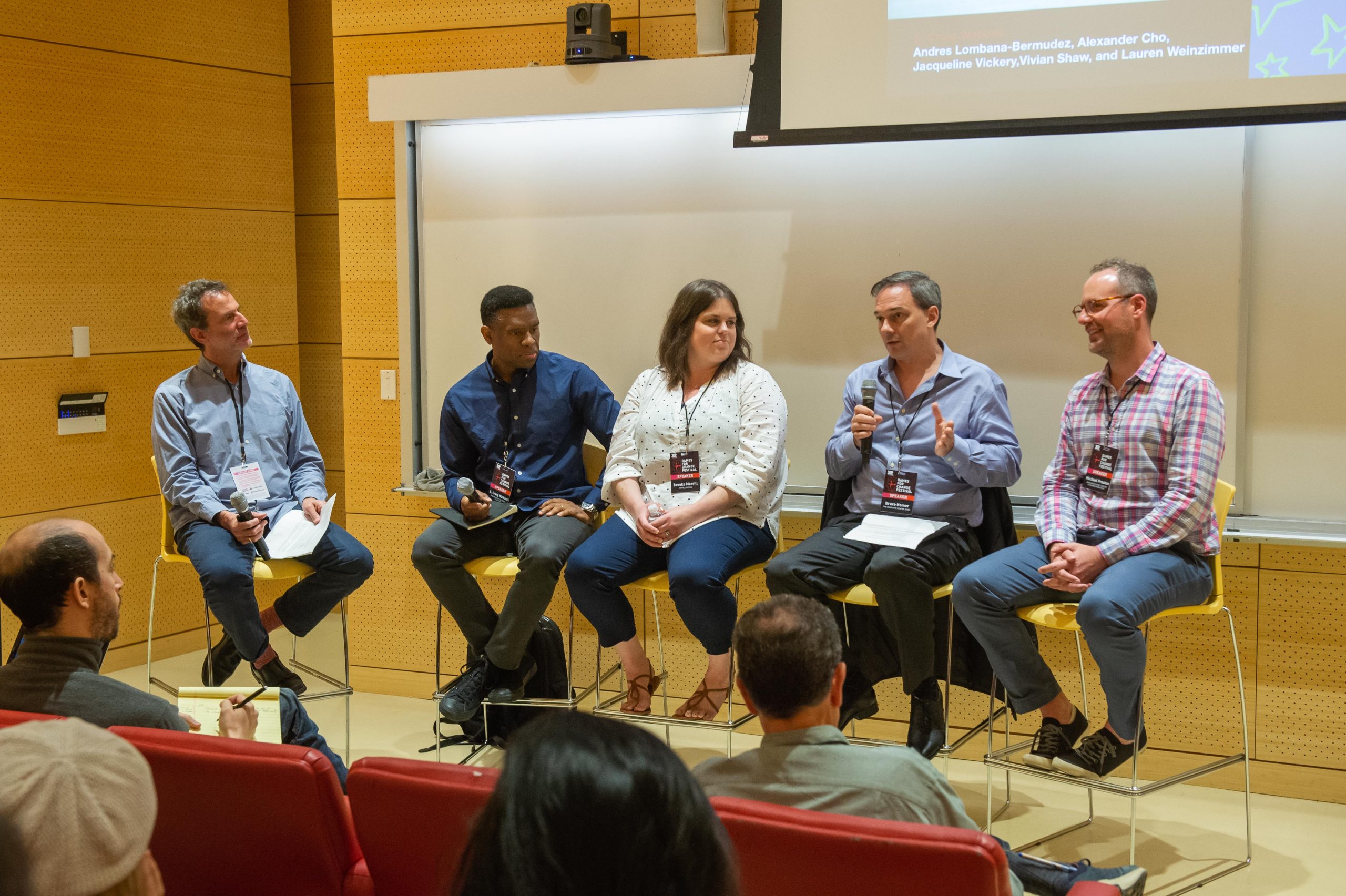In July 2022, the Joan Ganz Cooney Center hosted a panel at the Games for Change Festival in New York City. Led by Cooney Center Executive Director Michael Preston, the panel featured Idris Brewster, founder of tech nonprofit Movers and Shakers, which creates augmented reality (AR) experiences centered around uplifting Black and Brown narratives within the classroom with Kinfolk and Unsung; Kevin Merges, executive director of immersive technology programs at Rutgers Prep, a private K-12 school in Somerset, NJ; Peirce Clark, program manager at XR Association, an industry association committed to the responsible development and adoption of XR technologies; and Ellen Flaherty, senior manager of learning design, architecture, and strategy at Unity Technologies. Together, the panel discussed the affordances of immersive media to deepen learning and inspire real engagement among students.
Preston kicked off the discussion by explaining that this conversation would be focused on the potential for XR technologies, including virtual, augmented, and mixed reality, to truly engage students in deeper learning within high school settings. Because almost all American children go through schools, which are more or less similar across the country, the K-12 market has the potential to reach most kids. At the same time, there is a growing interest in fostering student-centered learning, in which students are empowered to take a more active role in their own education. What does this convergence mean for XR and student learning for teachers, and the developers who are creating the content and tools?
Students are excited about the potential of XR
Clark shared highlights from the XRA survey with teens, showing that teens are excited about virtual and augmented reality and enthusiastic about using it for STEM learning as well as for exploring the arts and creative studies. With a nod to Jeremy Bailenson’s criteria for using VR, Clark noted that students today have access to experiences that would otherwise be dangerous, like studying active volcanoes; impossible, such as exploring the rings of Saturn; or expensive, like visiting the Great Barrier Reef. They are able to explore these subjects in depth in a way that previous generations didn’t even have access to.

Gen Z feels empowered to create their own content, and are uniquely positioned to see things from different perspectives
Brewster pointed out that students have grown up with unprecedented access to tools and platforms that allow them to express themselves, including YouTube and TikTok. Flaherty noted that Unity aims to empower students to become creators by making the tools to build AR, VR, and XR experiences accessible. Merges observed that nearly all students today are versed in being on camera with Zoom. He also highlighted that this generation has grown up playing games like Minecraft that rely on mastery of the z-axis, which leads to an expectation and ability to manipulate virtual worlds in three dimensions. Together, these phenomena are likely to foster different expectations for creativity and production among this generation as they grow.
Teachers continue to need support
The panelists agreed that teachers need support in order to facilitate the implementation of XR technologies in the classroom. Their days are busy, and they are faced with teaching dozens of students and the unique challenges of accessibility, including hardware distribution. Merges highlighted the need to find strategies that are appropriate for each classroom. He raised a particular challenge that teachers might feel disconnected if students were simultaneously immersed in individual headsets, but pointed out that a student’s experience could be “cast” from their device onto a monitor so the class could follow along. To facilitate the implementation of Movers and Shakers products, Brewster created teacher dashboards that allowed teachers to get data on how their students were performing and worked to ensure that the software was accessible on a wide range of platforms that can be found in classrooms, from iPads and Android tablets to Chromebooks.
Flaherty also pointed out that because teachers are now at different stages along their own journeys of technical proficiency, professional development content must be modular and easily customized. Some teachers needed more guidance in setting up classrooms, while others wanted to implement an entire curriculum; still others might find it useful to take a few segments from a curriculum but wanted to modify the implementation for their own course.
Teachers and students must be learning partners
The practice of teaching may require a fundamental shift as these technologies become more ubiquitous, and students become more comfortable with taking risks. As Merges pointed out, “If we [teachers] are not paying attention to the students, then we’re not really student-centered.” Students today are more likely to feel comfortable hitting reset and starting over than their teachers are, because they have grown up with the understanding that they aren’t as likely to “break” things. But it will become increasingly important for teachers to help students build critical thinking and digital literacy skills. “Teachers are going to have to understand how to help students find primary sources and what’s the actual good stuff, because we know that over the last ten years, we have created a lot of content as a species, and not all of it has been accurate, let alone good.”
Brewster and Flaherty underscored the importance of understanding the evolving nature of social collaboration, as students work together to co-create content. “Working together and building something together just gets more buy-in and more interest and more engagement,” said Brewster. It will be critical for teachers and technologists to listen to students and how they speak with one another in order to spark creativity and even deeper engagement.
It takes deliberate effort and creativity to use emerging tech within existing standards-based curricula
While there’s agreement about XR’s potential to inspire deeper learning for students, it still remains a challenge for the majority of schools that may not have the resources or the teachers who are comfortable being the first to implement the technology within their schools. Beyond implementing Unity in computer science curricula, Flaherty pointed out that students should be exposed to emerging tech in order to be competitive in the future workforce. Brewster highlighted ways that the content of his applications might be “outside the bounds” of what might be required for a history class, so Movers and Shakers focused on creating reading comprehension questions within that immersive environment so teachers could measure students’ ability to analyze and discuss historical concepts using artifacts. Another program, Keep Talking and Nobody Explodes, is marketed as a social collaboration game — but can be used in Spanish in order to bring a fun twist to language learning.
The panel wrapped up with a look toward the future. Merges predicted there would be a “trifurcation” of education, in which we will see students learning within a mix of the traditional classroom, the continuation of the online learning that took off during the pandemic, and the emergence of virtual reality and the “metaverse”. Flaherty noted that Unity would soon be releasing AR Mobile pathway, which uses visual scripting to remove the barrier of coding for casual content creators. Brewster and Clark expressed enthusiasm for the pending arrival of AR glasses, which may be poised to fuel the mass adoption of AR. Clark mentioned XRA’s new Education Working Group, in which major industry players will participate in discussions about the ethical and responsible deployment of tech for learning, and Brewster previewed some of the family- and community-building work that they are doing to raise awareness of their products beyond the classroom.
Throughout the panel, a key undercurrent of the conversation was the importance of empowering students as active participants in their own learning. Ultimately, the discussion ended on a note of optimism: when developers, content creators, educators, and learning scientists keep the student’s learning experience in mind, the possibilities for inspiring generations of engaged learners with collaborative, resilient mindsets seem unlimited.




